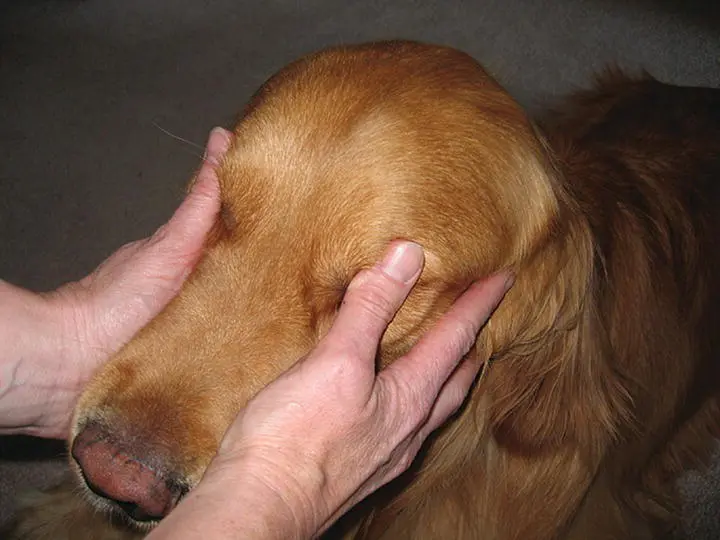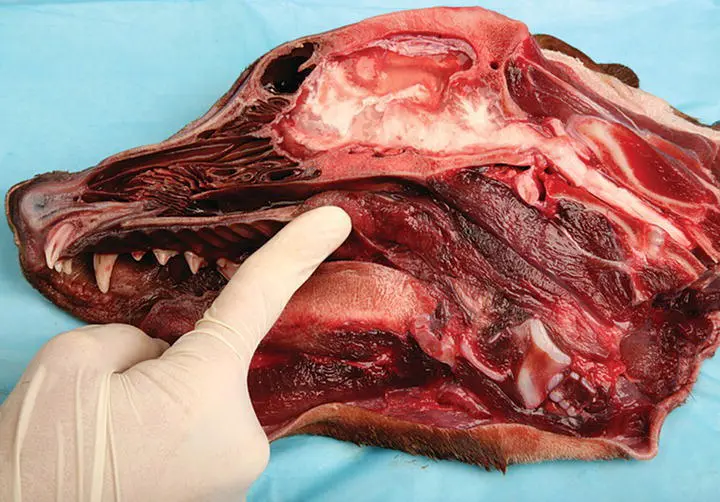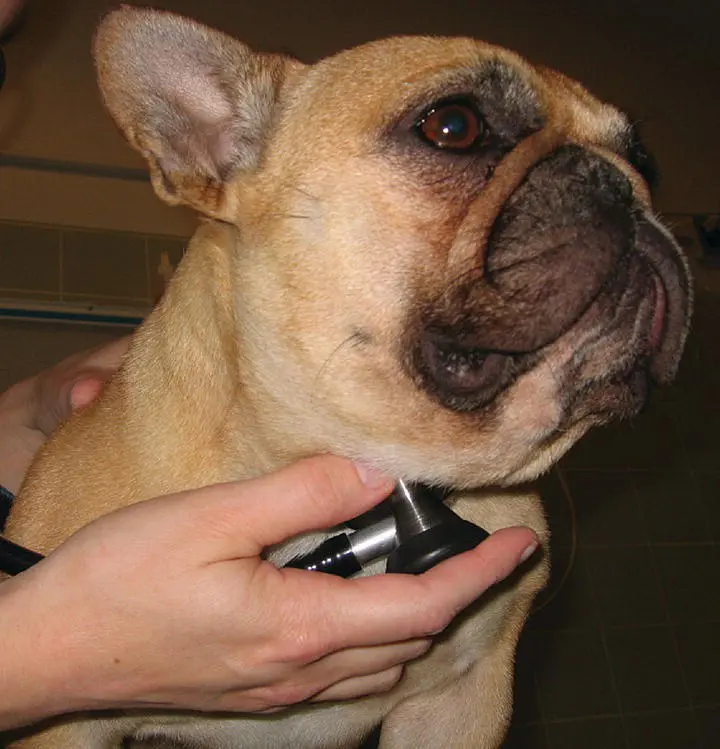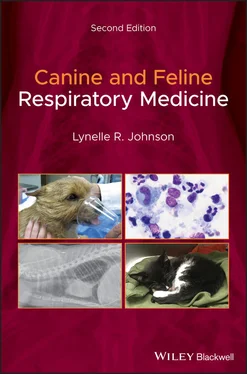
Figure 1.2 Palpation during ocular retropulsion can suggest the presence of a mass lesion in the optic canal or retrobulbar space.

Figure 1.3 In the normal animal, palpation of the soft palate will readily depress tissue into the dorsal nasopharyngeal wall. The presence of a mass lesion in the nasopharynx will result in resistance to depression.
Neoplastic disease or cryptococcosis within the nasal cavity leads to ipsilateral mandibular lymph node involvement and the disease process can sometimes be identified by cytology of a lymph node aspirate, even when there is no palpable enlargement. Nasal aspergillosis can result in reactive lymphadenopathy, although no fungal elements will be found. Nasal depigmentation along the drainage path of nasal discharge is a relatively specific feature of canine nasal aspergillosis found in up to 40% of cases and is thought to result from elaboration of a dermonecrotic toxin by the fungus (see Chapter 4).
Loud Breathing
Definition
Loud breathing most commonly results from a disorder affecting the nasal cavity or upper airway (larynx, pharynx, or cervical trachea), although occasionally animals with lower airway disease will present for loud, audible breathing. Stertor and stridor are loud sounds resulting from narrowing of upper or large airways typically, and are often audible without a stethoscope, although subtle stridor can be missed without specific auscultation over the larynx. Importantly, some animals will suffer from both stertor and stridor, which can have important ramifications for documenting the extent and severity of the obstructive disease, as well as defining optimal treatment.
Stertor is a discontinuous gurgling or snoring sound that is produced as air flows past a soft tissue obstruction in the upper airway. It can be caused by narrowing within the nasal cavity, by elongation or thickening of the soft palate, or by edema or eversion of laryngeal saccules. Tonsillar enlargement or mass lesions in the oral cavity can also lead to stertor. In brachycephalic dogs and cats, it is not possible to localize the source of stertor on physical examination alone and stertor is often multi‐factorial. Stertor varies in tone and pitch, and it can be audible on inspiration, expiration, or both.
In contrast, stridor is classically an inspiratory noise of a single, high pitch that results from rapid flow of air past a rigid obstruction, such as a paralyzed or collapsed larynx. Stridor can also be heard in an animal with a laryngeal mass or occasionally in an animal with nasopharyngeal stenosis. It can also be ausculted in an animal with a fixed large airway obstruction due to stenosis, hypoplasia, compression, or a mass effect. The airway obstruction can be anywhere from the larynx to the cervical or intrathoracic trachea. In severe cases where a large mass is obstructing airflow, stridor can be present on both inspiration and expiration. Finally, cervical tracheal collapse can also result in stridor typically on inspiration.
Epiglottic retroversion is a cause of intermittent airway obstruction in dogs in which respiratory distress is present in conjunction with stridor or stertor. Although rarely reported, it is increasingly recognized as a cause of serious clinical disease (see Chapter 5).
Stertor is commonly encountered in brachycephalic dog breeds such as bulldogs (English and French), Pugs, and Boston Terriers, and is also seen in Himalayan and Persian cats. Loud breathing is often present early in life and becomes worse with the development of additional respiratory disease or with weight gain. Some animals are not presented for evaluation of stertor and respiratory difficulty until late in life because of the perception that noisy respiration is “normal” for the breed.
Animals with stridor due to congenital laryngeal paralysis are usually young (6–12 weeks) when the clinical signs are first apparent, although some breeds show signs at 4–6 months and others at 1–2 years of age. Affected breeds include the Dalmatian, Rottweiler, Great Pyrenees, Bouvier des Flandres, Siberian Husky, White German Shepherd, and some cats (see Chapter 5). Acquired laryngeal paralysis is most commonly found in older large breed dogs such as Labrador and Golden Retrievers as part of a generalized polyneuropathy. Brachycephalic breed dogs that develop laryngeal collapse are usually older at the time of diagnosis; however, because this is an end‐stage manifestation of airway obstruction, the age at which the condition is recognized varies depending on the severity of the obstruction.
In a normal animal, breathing is quiet at rest. Stertor and stridor can be heard without the use of a stethoscope; however, in some instances, careful auscultation over the neck region is needed to confirm stridor. Increasing respiratory flow rate by gentle exercise can improve detection of stridor; however, panting must be discouraged. In the normal animal, auscultation over the larynx and trachea will reveal loud, hollow sounds that are heard equally on inspiration and expiration. Because upper respiratory noises are typically loud and can obscure lung sounds, auscultation of the larynx and tracheal region is recommended in all patients prior to thoracic auscultation to improve differentiation of upper from lower respiratory sounds, as well as to enhance detection of heart sounds and murmurs. This is particularly helpful in brachycephalic breeds ( Figure 1.4).

Figure 1.4 Prior to thoracic auscultation, the laryngeal and cervical tracheal regions are ausculted to define upper airway sounds.
Brachycephalic breeds commonly have visible stenotic nares as part of the disease complex, and excessive oropharyngeal folds can be evident, although it is difficult to assess palate length in the awake animal due to breed conformation and presence of excessive froth in the back of the throat. Confirming an appropriate gag reflex is important in evaluating the patient with stridor, because swallowing abnormalities can potentiate aspiration. Finally, the presence of bilateral nasal airflow assists in ruling out the nasopharynx as the site for generation of stridor.
Cough occurs because of activation of irritant receptors that lie between epithelial cells lining the airways and can be triggered by inflammatory products of neutrophils or eosinophils, by the presence of excess secretions, and by airway compression or collapse ( Table 1.2). Important historical features to determine include the onset and duration of cough, the character of the cough, and environmental features that appear to trigger cough.
The character of the cough described by the owner is occasionally helpful when prioritizing differential diagnoses, although substantial overlap exists among the causes of cough. Animals with a wet‐ or moist‐sounding cough can have excessive airway secretions due to infectious or inflammatory airway disease or as a result of parenchymal disease. Observant owners of the animal with a productive cough may note that the animal swallows after coughing or retches to remove secretions from the airway. However, diseases of the airway can also result in a dry cough when secretions are minimal or early in the course of disease. Cough in animals with airway disease is often harsh and can be chronic, intermittent, or paroxysmal in nature. Infectious respiratory disease in young puppies typically results in a hoarse, seal‐bark cough and this is often ascribed to bordetellosis. A honking cough is frequently described in dogs with tracheal or airway collapse and a brisk snapping sound on expiration is suggestive of large airway collapse. Animals with pneumonia might have a softer cough along with a vague history of illness characterized by anorexia and lethargy. Dogs with heart disease also can have a soft cough associated with tachypnea, exercise intolerance, or lethargy. With severe or fulminant pulmonary edema, a dog might expectorate pink foam if pulmonary edema has flooded the alveolar space and entered the airways. However, the common association of cough with congestive heart failure has been called into question (Ferasin et al. 2013).
Читать дальше















